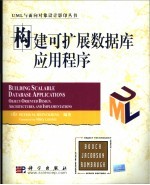

构建可扩展数据库应用程序PDF电子书下载
- 电子书积分:12 积分如何计算积分?
- 作 者:(美)海金斯(Heinckiens,P.M.)编著
- 出 版 社:北京:科学出版社
- 出版年份:2004
- ISBN:7030124936
- 页数:311 页
3.5 Example:Student Administration 3 1
Part One An Object-Oriented View on Persistence 1
Chapter 1 A New Generation of Software 3
1.1 FromDatatoInformation 3
1.2 Improving Software Quality 4
1.3 Databases Everywhere 4
1.4 ToHave andtoHold 5
1.5 Concentrating on the Essence 5
1.6 The Importance of Scalability 6
1.7 Application Program Interfaces 7
1.8 TheRoadtoFollow 7
2.1 Walking among Dinosaurs 9
Chapter 2 The Database Community Today 9
2.3 Database Users 10
2.2 Database Usage 10
2.4 Designing Database Applications 11
Contents 11
Foreword 11
2.5 Relational Databases 12
Preface 13
2.6 Client/Server Systems 15
Acknowledgments 17
2.7 Distributed Software 18
2.8 Problems with Traditional Systems 19
About theAuthor 19
2.9 4GL:The Solution? 20
2.10 Object-Oriented Databases 21
2.11 Preserving Openness 23
2.12 Summary 24
3.1 Data-Driven Software Design 25
Chapter 3 An Object-Oriented View on Database Applications 25
3.2 Supporting Multiple Applications 28
3.3 Object-Oriented Software Design 29
3.4 The Object Model 30
3.6 Business Models and Supporting Multiple Applications 34
3.7 C++,Java,or Smalltalk:The Ultimate Answer? 35
3.8 Building Reusable Software 38
3.11 User Interfaces 40
3.10 Object Orientation and Client/Server Design 40
3.9 Toward Open Client/Server Applications 40
3.12 Analogy between User Interfaces and Databases 41
3.13 Object-Oriented or Relational? 43
3.14 Persistence from a Different Angle 44
3.15 Persistence and Separation of Concerns 44
3.16 Safety Issues 46
3.17 Summary 46
Part Two An Architecture for Object Persistence 47
4.1 Introduction 49
Chapter 4 Making Objects Persistent 49
4.2 Basic Requirements of a Persistence Framework 50
4.3 Obtaining Scalability 50
4.4 Interfacing with a Relational World:Problems to Conquer 51
4.5 Abstracting the Database 57
4.6 An Architecture for Object Persistence 58
4.7 Summary 60
5.1 A Persistent Container Class 61
5.2 Basic Functionality of PSet 61
Chapter 5 Abstracting the Database 61
5.3 Implementing the Persistence Architecture 63
5.4 Resolving the Impedance Mismatch 65
5.5 Reading and Writing Objects 71
5.6 Direct Instances of PSet 73
5.7 Searching for Objects 75
5.8 Supporting Multiple Technologies 79
5.9 Summary 81
6.1 Deriving from PSet 83
Chapter 6 Encapsulating Data Access 83
6.2 Example:Class City 87
6.3 Using Class City 93
6.4 Member Objects 93
6.5 Derived IM Resolvers 94
6.6 Class Extension 99
6.7 Compile-Time Decoupling 100
6.8 Reuse and Migration to Other Technologies 104
6.9 Summary 104
Part Three Implementing Business Models 105
7.1 Developing a Simple Invoicing System 107
Chapter 7 Designing Business Objects 107
7.2 Searching Compound Objects 116
7.3 Object ID versus Primary Key 118
7.4 Developing Generic IM Resolvers 121
7.5 An OID-Based Reference Class 126
7.6 Supporting Existing Database Layouts 130
7.7 Versioning 131
7.8 Stability of Program Code against Schema Changes 134
7.9 Storing Multimedia Objects 135
7.10 Efficiency 139
7.11 Summary 145
Chapter 8 Inheritance of Persistent Objects 147
8.1 Specialization:Using Inheritance for Reuse 147
8.2 Generalization:Using Inheritance for Polymorphism 152
8.3 Using Generalizations as Member Objects 158
8.4 Inheritance in Relational Database Systems 162
8.5 Designing Reusable Software Components 170
8.6 Summary 173
9.1 Many-to-One Relationships 175
Chapter 9 Associations 175
9.2 Attributes versus Associations 176
9.3 Collections:One-to-Many Relationships 178
9.4 Associations and Reuse 186
9.5 Many-to-Many Relationships 188
9.6 A Closer Look at Associations 189
9.7 Associations as Independent Entities 191
9.8 Referential Integrity 197
9.9 Summary 202
10.2 The ACID Test 203
Chapter 10 Transaction Management and Concurrency Control 203
10.1 The Transaction 203
10.3 Transaction Management Exceeds the Database Level 205
10.4 Concurrency Control:Locking 206
10.5 Example:A Transaction Class 211
10.6 Transactions in Relational Database Systems 212
10.7 Using Transactions 214
10.8 Nested Transactions 215
10.9 Distributed DatabaseSystems 217
10.10 Other Levels ofConcurrency 219
10.11 Lock Notification through Call-Back Functions 221
10.12 Summary 222
Chapter 11 The Front End 223
11.1 Analogy between User Interfaces and Databases 223
11.2 Separating the User Interface from the Business Model 223
11.3 WhattoPutWhere 229
11.4 Navigating through Persistent Sets 229
11.5 Summary 234
12.1 ProjectDefinition 235
Chapter 12 Case Study:An Electronic Telephone Directory 235
12.2 Comparing Development Approaches 236
12.3 Designing the User Interface 237
12.4 The Database Model 240
12.5 Designing the Business Model 240
12.6 Comparing the Business Model and the Database Model 243
12.7 Implementing the Business Objects 244
12.8 Making Classes Persistent 250
12.9 Impedance Mismatch Examples 257
12.10 Implementing the User Interface 263
12.11 Summary 275
Chapter 13 Toward Open Applications 277
13.1 Third-Party Access to Your Application's Data 278
13.2 Standard Report Generators and Query Tools 278
13.3 Informationbases 281
13.4 Interoperability with Other Applications 282
13.5 Implementing an Informationbase 285
13.6 Architecture for Next-Generation Software 286
13.7 Summary 289
Chapter 14 Conclusion 291
Appendix DBtools-Based Implementation of Scoop 293
PSet 293
DataSet 294
IM Resolver 294
Resolving Impedance Mismatch 295
Building the Select Statement 296
References 297
Index 301
- 《钒产业技术及应用》高峰,彭清静,华骏主编 2019
- 《现代水泥技术发展与应用论文集》天津水泥工业设计研究院有限公司编 2019
- 《英汉翻译理论的多维阐释及应用剖析》常瑞娟著 2019
- 《数据库技术与应用 Access 2010 微课版 第2版》刘卫国主编 2020
- 《区块链DAPP开发入门、代码实现、场景应用》李万胜著 2019
- 《虚拟流域环境理论技术研究与应用》冶运涛蒋云钟梁犁丽曹引等编著 2019
- 《当代翻译美学的理论诠释与应用解读》宁建庚著 2019
- 《第一性原理方法及应用》李青坤著 2019
- 《程序逻辑及C语言编程》卢卫中,杨丽芳主编 2019
- 《教师教育系列教材 心理学原理与应用 第2版 视频版》郑红,倪嘉波,刘亨荣编;陈冬梅责编 2020
- 《指向核心素养 北京十一学校名师教学设计 英语 七年级 上 配人教版》周志英总主编 2019
- 《《走近科学》精选丛书 中国UFO悬案调查》郭之文 2019
- 《北京生态环境保护》《北京环境保护丛书》编委会编著 2018
- 《中医骨伤科学》赵文海,张俐,温建民著 2017
- 《美国小学分级阅读 二级D 地球科学&物质科学》本书编委会 2016
- 《指向核心素养 北京十一学校名师教学设计 英语 九年级 上 配人教版》周志英总主编 2019
- 《强磁场下的基础科学问题》中国科学院编 2020
- 《小牛顿科学故事馆 进化论的故事》小牛顿科学教育公司编辑团队 2018
- 《小牛顿科学故事馆 医学的故事》小牛顿科学教育公司编辑团队 2018
- 《高等院校旅游专业系列教材 旅游企业岗位培训系列教材 新编北京导游英语》杨昆,鄢莉,谭明华 2019
